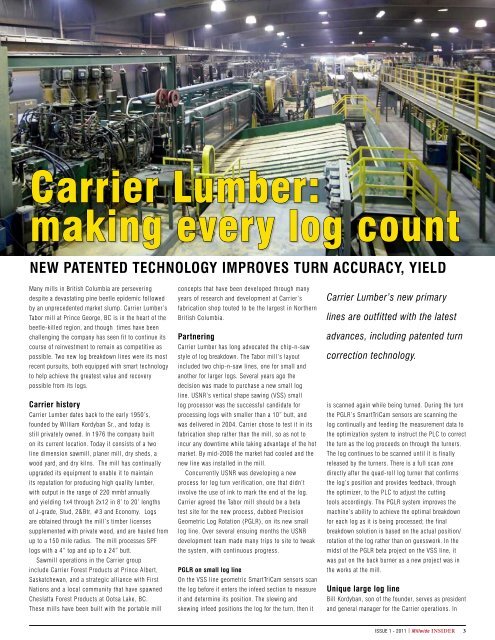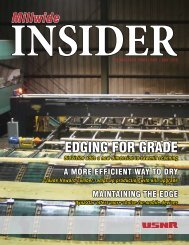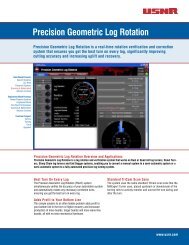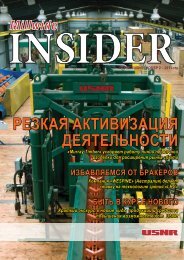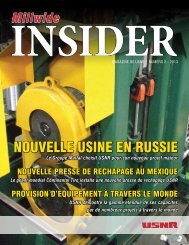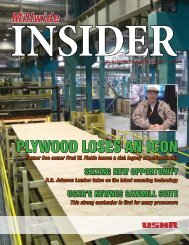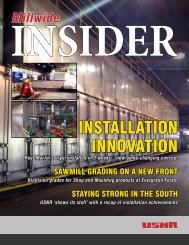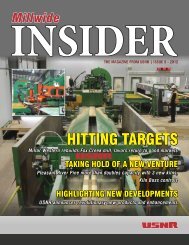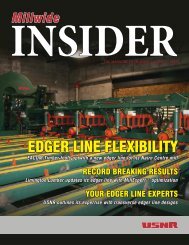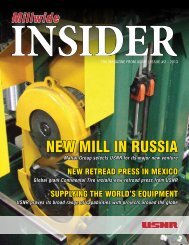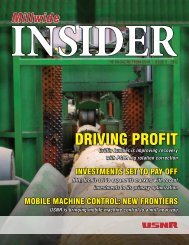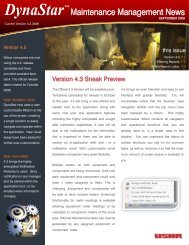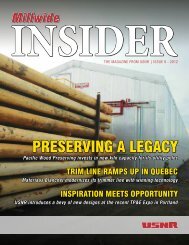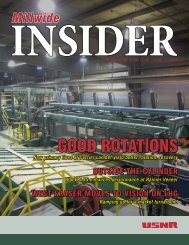Carrier Lumber: making every log count - Coe Manufacturing Co.
Carrier Lumber: making every log count - Coe Manufacturing Co.
Carrier Lumber: making every log count - Coe Manufacturing Co.
You also want an ePaper? Increase the reach of your titles
YUMPU automatically turns print PDFs into web optimized ePapers that Google loves.
<strong>Carrier</strong> <strong>Lumber</strong>:<strong>making</strong> <strong>every</strong> <strong>log</strong> <strong>count</strong>New patented techno<strong>log</strong>y IMPROVes TURN ACCURACY, YIELDMany mills in British <strong>Co</strong>lumbia are perseveringdespite a devastating pine beetle epidemic followedby an unprecedented market slump. <strong>Carrier</strong> <strong>Lumber</strong>’sTabor mill at Prince George, BC is in the heart of thebeetle-killed region, and though times have beenchallenging the company has seen fit to continue itscourse of reinvestment to remain as competitive aspossible. Two new <strong>log</strong> breakdown lines were its mostrecent pursuits, both equipped with smart techno<strong>log</strong>yto help achieve the greatest value and recoverypossible from its <strong>log</strong>s.<strong>Carrier</strong> history<strong>Carrier</strong> <strong>Lumber</strong> dates back to the early 1950’s,founded by William Kordyban Sr., and today isstill privately owned. In 1976 the company builton its current location. Today it consists of a twoline dimension sawmill, planer mill, dry sheds, awood yard, and dry kilns. The mill has continuallyupgraded its equipment to enable it to maintainits reputation for producing high quality lumber,with output in the range of 220 mmbf annuallyand yielding 1x4 through 2x12 in 8’ to 20’ lengthsof J-grade, Stud, 2&Btr, #3 and Economy. Logsare obtained through the mill’s timber licensessupplemented with private wood, and are hauled fromup to a 150 mile radius. The mill processes SPF<strong>log</strong>s with a 4” top and up to a 24” butt.Sawmill operations in the <strong>Carrier</strong> groupinclude <strong>Carrier</strong> Forest Products at Prince Albert,Saskatchewan, and a strategic alliance with FirstNations and a local community that have spawnedCheslatta Forest Products at Ootsa Lake, BC.These mills have been built with the portable millconcepts that have been developed through manyyears of research and development at <strong>Carrier</strong>’sfabrication shop touted to be the largest in NorthernBritish <strong>Co</strong>lumbia.Partnering<strong>Carrier</strong> <strong>Lumber</strong> has long advocated the chip-n-sawstyle of <strong>log</strong> breakdown. The Tabor mill’s layoutincluded two chip-n-saw lines, one for small andanother for larger <strong>log</strong>s. Several years ago thedecision was made to purchase a new small <strong>log</strong>line. USNR’s vertical shape sawing (VSS) small<strong>log</strong> processor was the successful candidate forprocessing <strong>log</strong>s with smaller than a 10” butt, andwas delivered in 2004. <strong>Carrier</strong> chose to test it in itsfabrication shop rather than the mill, so as not toincur any downtime while taking advantage of the hotmarket. By mid-2008 the market had cooled and thenew line was installed in the mill.<strong>Co</strong>ncurrently USNR was developing a newprocess for <strong>log</strong> turn verification, one that didn’tinvolve the use of ink to mark the end of the <strong>log</strong>.<strong>Carrier</strong> agreed the Tabor mill should be a betatest site for the new process, dubbed PrecisionGeometric Log Rotation (PGLR), on its new small<strong>log</strong> line. Over several ensuing months the USNRdevelopment team made many trips to site to tweakthe system, with continuous progress.PGLR on small <strong>log</strong> lineOn the VSS line geometric SmartTriCam sensors scanthe <strong>log</strong> before it enters the infeed section to measureit and determine its position. The slewing andskewing infeed positions the <strong>log</strong> for the turn, then it<strong>Carrier</strong> <strong>Lumber</strong>’s new primarylines are outfitted with the latestadvances, including patented turncorrection techno<strong>log</strong>y.is scanned again while being turned. During the turnthe PGLR’s SmartTriCam sensors are scanning the<strong>log</strong> continually and feeding the measurement data tothe optimization system to instruct the PLC to correctthe turn as the <strong>log</strong> proceeds on through the turners.The <strong>log</strong> continues to be scanned until it is finallyreleased by the turners. There is a full scan zonedirectly after the quad-roll <strong>log</strong> turner that confirmsthe <strong>log</strong>’s position and provides feedback, throughthe optimizer, to the PLC to adjust the cuttingtools accordingly. The PGLR system improves themachine’s ability to achieve the optimal breakdownfor each <strong>log</strong> as it is being processed; the finalbreakdown solution is based on the actual position/rotation of the <strong>log</strong> rather than on guesswork. In themidst of the PGLR beta project on the VSS line, itwas put on the back burner as a new project was inthe works at the mill.Unique large <strong>log</strong> lineBill Kordyban, son of the founder, serves as presidentand general manager for the <strong>Carrier</strong> operations. InISSUE 1 - 2011 | Millwide INSIDER
less, thus allowing the machine to cut faster. Forexample, an 8” <strong>log</strong> can be cut at the same speed asa single arbor saw cutting a 4” <strong>log</strong>. Balancing thecut also fills the gullets therefore minimizing thesaw step or match line. This style of breakdown istypically used for smaller <strong>log</strong>s, but Kordyban alsothought it was a good design for the large <strong>log</strong> line.The large <strong>log</strong> line is fed by two feed modules, depending on the size of the <strong>log</strong>.2009 he decided a new large <strong>log</strong> line for Tabor was orients it prior to breakdown; the first scannerthe next step in modernizing the breakdown process, measures the latter half of the <strong>log</strong>, while the secondand again selected USNR to supply the equipment. scanner measures the first half. The <strong>log</strong> is thenThe PGLR system was included as part of the scope fed through the profiling canter section where it isof supply on that line as well, and it became the new processed by side chip heads and top and bottombeta for PGLR completion.profiling heads. Then the cant transfer conveyorThe large <strong>log</strong> line is nearly 260 feet in length. transports the <strong>log</strong> to the sawboxes. This machineTwo <strong>log</strong> bins are used to sort <strong>log</strong>s based on size, is equipped with two quad arbor sawboxes in line;and feed them to the infeed conveyor. The <strong>log</strong>s are <strong>log</strong>s smaller than 14” are processed through thefirst scanned ahead of the turning rolls for optimized first sawbox with the capability to take off fourpositioning. As each <strong>log</strong> enters the turning rolls sideboards using thinner kerf saws, and largerit is scanned by the PGLR scanner, located at the <strong>log</strong>s go on through to the second sawbox with theentrance to the rolls, and continues to be scanned capability to take off six sideboards using thickeruntil the rolls release it onto the extended length kerf saws.infeed section. Throughout this scanning processThe sawboxes each have a pivoting top arbor sawthe turning rolls are continually correcting the <strong>log</strong>’s that swings down in front of the bottom saw and cutsposition based on feedback from the PGLR scanner. the top part of the <strong>log</strong>, while the bottom saw cutsThe extended length slewing, skewing and tilt the remainder. Speed is the advantage with this type(SST) infeed is capable to move the <strong>log</strong> in both of breakdown as it can cut faster than a bandmill.vertical and horizontal planes. Here, two moreThe pivoting top arbor design balances the cutscanners verify the <strong>log</strong>’s position as the infeedbetween the two saws so each saw is required to cutThe first sawbox takes up to four sideboards off each piece,while the second sawbox, located just downstream,is capable of taking off up to six sideboards.Customer focused innovationsUSNR is cognizant of the value of customers like<strong>Carrier</strong> that are willing to test out new products suchas the PGLR. USNR also knows that innovations aresometimes brought to light by customers that haveinventive ideas about how to achieve their goals. Byworking together unique concepts can become the newreality. The mill floor is the proving ground for newinnovations, and USNR appreciates the opportunityto work together with our customers to a commonend. Every installation USNR is involved with has itsown unique requirements, thus each line becomes acustom-fit.A member of the <strong>Carrier</strong> team, Kelly Solmonsonis coordinator for all of its mills. Kelly explains,“Our goal is to have equipment that is the bestthat is out there. Our team believes that when youtake ownership of a piece of equipment you tend tolook after it better and take pride in how it runs.”Kelly went on to explain, “We’re continuing to makeimprovements (on the large <strong>log</strong> line) to achievethe high standards that we are looking for in ourequipment. USNR has been more than cooperativewhen we’ve wanted to make changes.”And what about the performance of the VSSmachine? <strong>Carrier</strong>’s preference was for the small <strong>log</strong>machine to do top and bottom profiling, with sideboards still going to the edger. Kelly feels the small<strong>log</strong> line runs as well as any in the industry.Testing for turnPaul Green, optimization engineer who worked onthe development of the PGLR system, explainedthe theory behind its design. “The PGLR systemimproves recovery by getting the <strong>log</strong> closer to theideal rotation angle called for by the turn optimizer.Studies have shown that on <strong>log</strong> turners runningwithout any correction, the standard deviation ofthe turn error can be much higher than most peoplethink. Part of the reason this surprises peopleis that rotation accuracy studies are very timeconsuming to do, so most mills don’t know howtheir machine is performing.”He went on to say, “USNR has a history ofexperience measuring the performance of <strong>log</strong>turners starting with manual angle measurements,Precision Log Rotation (PLR) using ink stripe andcamera, and now our PGLR laser scanning systemto measure and correct as the <strong>log</strong> is being turned.We are also developing a turn detector usingimage processing techno<strong>log</strong>y to measure the finalturn accuracy of the <strong>log</strong> as it enters the cuttingMillwide INSIDER | ISSUE 1 - 2011
tools. The turn detector can report the accuracy on<strong>every</strong> <strong>log</strong>, as well as a running average and end-ofshift-reports. As these tools become availablethe typical accuracy for a <strong>log</strong> turner is becomingmore widely understood. USNR’s PGLR system isunique in that diagnostics show plots of the turnmeasurements throughout the turn and reports ongoingturn accuracy over the previous 1000 <strong>log</strong>s.”Eye-opening resultsUSNR’s experience with testing turn error/accuracyhas yielded eye-opening results. The cutting deviceson any <strong>log</strong> breakdown system are set assumingan almost perfect turn in the <strong>log</strong> turner. Howeverin practical terms the turn is seldom perfect,resulting in lost recovery. Testing has shown that byrescanning to determine the exact position of the <strong>log</strong>,and the ability to reset the cutting tools accordingly,results in significant improvement in recovery. Turnerror can typically improve from a average absoluteturn error of over 8 degrees to an average absoluteturn error of under 4 degrees with turn correction.This can yield recovery improvements from 91% to96%. Many variables come into play when measuringturn accuracy; with larger <strong>log</strong>s high turn accuracy istypically much easier to achieve.Final acceptance testing for the PGLR system onthe large <strong>log</strong> line was run in May 2010, followed bythe VSS line in October. The results of the two testsachieved standard deviations a great deal betterthan promised and required by contract. USNR wasrecently awarded patents covering the concept.When asked his opinion of the results fromthe PGLR systems, Kelly said, “It is more of aconfirmation that we are doing things right. The PGLRsystem, for us, is a second check to ensure that wehave the recovery we were expecting to achieve.”A potent combination<strong>Carrier</strong> <strong>Lumber</strong> believes strongly in the benefit ofsmart techno<strong>log</strong>y to reap the greatest value andrecovery from its fiber supply. <strong>Carrier</strong> also believesits strength is in its team of people, and all playan integral role in how its equipment runs. Kellyelaborated, “If you get people buying into theequipment they’ll make it work. Our installs go verywell; <strong>Carrier</strong> <strong>Lumber</strong> employees understand that<strong>every</strong>one has an opportunity to make a difference.”Future horizonsOn the issue of the pine beetle epidemic in BC,<strong>Carrier</strong> feels that the epidemic has run its course andthe bulk of the mature pine stands have been killed.In retrospect, the right thing was done to managethe epidemic by having the mills salvage as muchas possible. <strong>Carrier</strong> believes that all the mills havedone an admirable job of dealing with the volume ofwood processed.<strong>Carrier</strong> continues to look at ways to improve soit can maintain its commitment to its customersto provide them with high quality lumber. With thelatest advances in techno<strong>log</strong>y <strong>Carrier</strong> has made toits primary end, it is <strong>making</strong> <strong>every</strong> <strong>log</strong> <strong>count</strong>.The PGLR interface shows turn accuracy results from one <strong>log</strong>. The turn error on thisparticular <strong>log</strong> was only 3.12 degrees.ISSUE 1 - 2011 | Millwide INSIDER
machine section. Four Smart TriCam 3D sensorsscan the <strong>log</strong> in real time as it is being rotated. Thecurrent <strong>log</strong> rotation path is compared to the autorotation optimizer’s projected <strong>log</strong> rotation path togenerate <strong>log</strong> rotation corrections. The <strong>log</strong> rotationcorrections are transmitted to the PLC for correctionof the <strong>log</strong> rotation path as it continues through the<strong>log</strong> turner.PGLR works on dual or quad roll <strong>log</strong> turners,donut turners, sharp chain <strong>log</strong> turners and enddogger systems. It enables you to convert a manualsystem to semi-automatic, or a semi-automaticsystem to a fully automated precision <strong>log</strong> turningsystem. Currently PGLR is compatible with SmartTriCam scanning and MillExpert optimization. Toupgrade a line without these components will alsorequire conversion to these systems.PGLR compensates for <strong>log</strong> turning errorsPGLR can compensate for <strong>log</strong> turning errors causedby the following.► Mechanical wear► Feed speed changes during the turn► Irregularly shaped and crooked <strong>log</strong>s► Transfers from one conveyor to the next► Interaction with pressrolls► Slippage and hesitationsPerformance results all day, <strong>every</strong> dayThe reports built into the PGLR system providediagnostics on how well your turning system isworking, in real time. The mill can record historicaltrending for turn accuracy vs. recovery, enablingit to quantify performance. Piece-by-piece turncorrection results and trends are available forup to the last 1000 <strong>log</strong>s, including variousturn correction statistics to help diagnose andimprove turning performance. It provides completeinformation on production and performance, andhelps management make the right decisions at theright time.Winning solution catches on withcustomersSince the product’s launch in 2010, USNR has soldor installed eight PGLR systems. Of these, four arecombined with other vendors’ <strong>log</strong> breakdown lines.One of the recent upgrade sites is so pleasedwith their results that a sister mill is alsoplanning to implement PGLR. Several more sitesare currently appraising the product. To fully evaluatethe benefits of upgrading your existing <strong>log</strong> breakdownsystem or include PGLR in your next new capitalproject, please contact your USNR representative.The PGLR software is straightforward with a hostof diagnostic tools to help tune the mechanical aswell as the PLC control systems. Graphs and onscreenindicators permit early detection of problemsand overall performance at a glance. Reports aregenerated to isolate issues relating to a particularclass of <strong>log</strong> and to track longer term trends. Thissimple solution to an often hidden problem addsprofit in the form of higher recovery and increasedproduction of more boards, longer boards and morewane-free boards, all with no extra mechanicalhardware. <strong>Co</strong>nsider that a mis-turn of as little as2° could wipe out an entire board in a small <strong>log</strong>.Major benefits of PGLR include the following.► Significantly improves cutting accuracy► Increases uplift and recovery► Allows you to cut more boards, longer boards andmore wane-free boards.Installs over a weekendWhen you decide to upgrade your <strong>log</strong> breakdownline with PGLR, this is what you’ll get. The PGLRsystem consists of four Smart TriCam sensors withassociated hardware, wiring and a PGLR computerwhich is installed in the existing optimizer computerenclosure. The Smart TriCam sensors are mountedvia a framework that is bolted to the existing framehousing the turning rolls. PGLR works with yourexisting <strong>log</strong> breakdown control system, with somesoftware modifications. The whole upgrade can beperformed over a weekend, then you’ll start your newweek <strong>making</strong> <strong>every</strong> <strong>log</strong> <strong>count</strong>!Upstream:initial scanPGLR rescanTurning rollsFinal QC rescanISSUE 1 - 2011 | Millwide INSIDER


